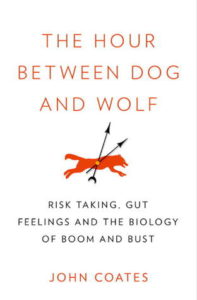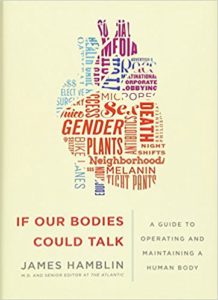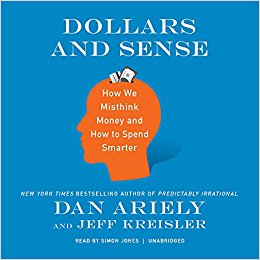The Hour Between Dog and Wolf: Risk Taking, Gut Feelings and the Biology of Boom and Bust
by John Coates, 2012
Really good book. Written through the lens of a former financial trader who went back to school to study the effect of our body on risk-taking and decision-making. Our irrational exuberance during bull markets is caused by our physical chemistry, as is our learned helplessness during bear markets. Covers topics in finance, biology, philosophy, and management.
Here are a few excerpts, though there are many more interesting ideas in the book as well. The sections on the influence of testosterone and cortisol are harder to excerpt.
Take for instance the ways in which the brain deals with the problem of the on-tenth-of-a-second delay between viewing a moving object and becoming consciously aware of it. Such a delay puts us in constant danger, so the brain’s visual circuits have devised an ingenious way of helping us. The brain anticipates the actual location of the object, and moves the visual image we end up seeing to this hypothetical new location. In other words, your visual system fast-forwards what you see.
An extraordinary idea, but how on earth could we ever know it to be true? Neuroscientists are devilishly clever at tricking the brain into revealing its secrets, and in this case they have recorded the visual fast-forwarding by means of an experiment investigating what is called the “flash-lag effect.” In this experiment a person is shown an object, say a blue circle, with another circle inside it, a yellow one. The small yellow circle flashes on and off, so what you see is a blue circle with a yellow circle blinking inside it. Then the blue circle with the yellow one inside starts moving around your computer screen. What you should see is a moving blue circle with a blinking yellow one inside it. But you do not. Instead you see a blue circle moving around the screen with a blinking yellow circle trailing about a quarter of an inch behind it. What is going on is this: while the blue circle is moving, your brain advances the image to its anticipated actual location, given the one-tenth-of-a-second time lag between viewing it and being aware of it. But the yellow circle, blinking on and off, cannot be anticipated, so it is not advanced. It thus appears to be left behind by the fast-forwarded blue circle. (pg 70)
…
A game was played in which participants could select from two decks of cards, one which gave a positive expected return and the other which gave a negative expected return.
When they played the game, all participants were monitored for a somatic marker, the electrical conductivity of their skin. Your skin experiences rapid and unnoticed changes in electrical conductivity, the result of momentary changes in the amount of sweat lying in its crevices. Skin conductance is highly sensitive to novelty, uncertainty and stress. The players’ skin conductance began to spike when they contemplated playing from the money-losing decks, and this somatic prod proved enough to steer them away from these dangerous choices. Aided by these brief shocks, normal players were guided toward the money-making decks long before their conscious rationality had figured out why they should be doing so. (pg 118)
…
Problems lurk in this Y chromosome. Chromosomes normally swap genetic material, a process known as recombination, and this exchange has the felicitous effect of repairing any damaged genetic material, ensuring our continued health. Genetic recombination can be compared to the regular servicing you schedule for your car, in which old parts are replaced by new ones. Our chromosomes do much the same thing when they recombine–they exchange old and broken genetic parts for new ones. An X chromosome can swap material with another X chromosome, thus ensuring that each generation is fitted with new parts. But not so the isolated Y. This lone wolf has nothing it can swap with, so over time, like a car that is never serviced, it compounds problems and accumulates damage until its genes, one by one, die off. Some animals, such as the kangaroo, now have only a few genes remaining on their Y chromosome. This slow death of the Y has been called Adam’s Curse by the Oxford geneticist Bryan Sykes, who predicts that in five thousand generations men will be extinct. (pg 167)


